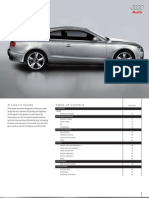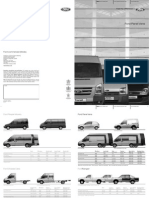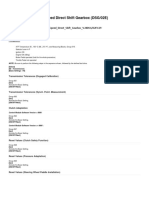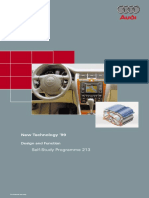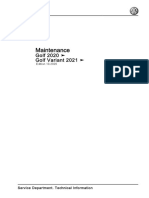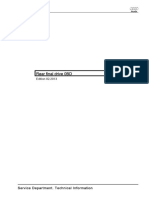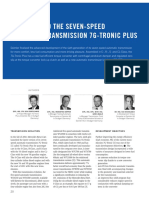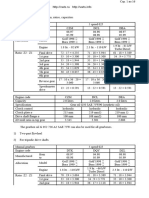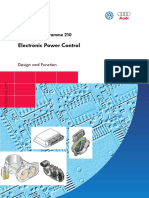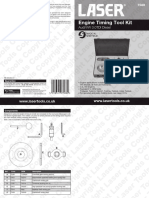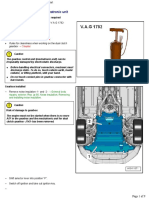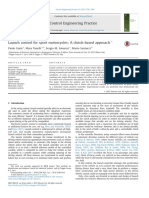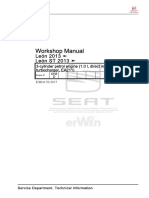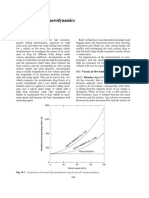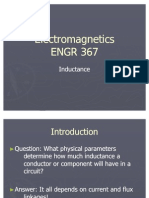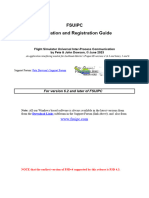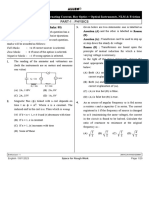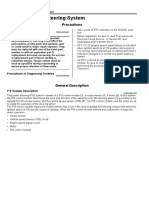Motec Gear Change Ignition Cut
Motec Gear Change Ignition Cut
Uploaded by
OutlawRCopyright:
Available Formats
Motec Gear Change Ignition Cut
Motec Gear Change Ignition Cut
Uploaded by
OutlawRCopyright
Available Formats
Share this document
Did you find this document useful?
Is this content inappropriate?
Copyright:
Available Formats
Motec Gear Change Ignition Cut
Motec Gear Change Ignition Cut
Uploaded by
OutlawRCopyright:
Available Formats
Technical Note
Document Number
CTN0004
Title
Gear Change Ignition Cut
Approved By
Revision
1.0
Date
30/04/09
Prepared By
MM
Change History
Scope
The following document details the setup of the Gear Change Ignition Cut function (GCIC)
available in MoTeC ECUs. The document is based on the version 3.5 and above software for
the hundred series ECUs (M400, M600, M800 and M880). Earlier versions of hundred series
software and other MoTeC ECU types and not specifically detailed in this document but the
information presented with still be relevant.
Gear Change Ignition Cut
The MoTeC GCIC function is used to allow the driver to change gears without lifting the
throttle or (in most cases) the clutch, it is also often referred to as Flat Shift or Shift without
Lift. The system allows a short ignition or fuel cut and/or ignition timing retard to reduce the
engines load on the transmission so that the gear can be changed. It is also possible to have
the position of an Electronic Throttle (Drive by Wire) reduced for a short amount of time as
well.
The function is designed with both H pattern and sequential, dog engagement gear boxes in
mind, it should be noted that this function is not completely suitable for synchromesh
gearboxes.
Cut Modes
Mode 1, Delay from next gear stable
This mode is only suitable when the ECU has a gear position input. The ignition cut starts as
soon as a valid shift signal is detected and will hold for however long it takes for the gear
position pot or gear calculation to detect the next gear has been reached or the Minimum
RPM or Minimum Throttle Position have been reached. The Delay time starts when the new
gear is detected to allow time for full engagement then the ignition is phased back in linearly
over the recovery time.
Copyright MoTeC Pty Ltd
Reproduction in whole or in part is prohibited without written approval from MoTeC Pty Ltd.
Page 1 of 16
MoTeC Pty Ltd
CTN0004 Gear Change Ignition Cut
Mode 2, Delay from Cut Signal
The Delay from Cut Signal mode starts the ignition cut when the cut source becomes active
and runs for the user defined Delay time (as set in Delay Table). After the delay has timed out
the ignition Recovery time starts.
Mode 3, Cut While Signal is active
This mode will simply cut the ignition for as long as the shift signal is active. No delay times are
entered for this mode. Mode 3 is mainly designed for external gear box control systems that
are able to send a GCIC signal to the ECU; the cut time is calculated in the external
controller.
Page 2 of 16
MoTeC Pty Ltd
CTN0004 Gear Change Ignition Cut
It can be seen from the previous two diagrams that the gear position does not affect the cut
at all.
Cut Source
To make the GCIC system work the ECU needs a request that the driver wishes to make an up
shift, there are a number of options for this. It is possible that race class rules may only allow
certain methods for GCIC so the rule book will need to be checked.
1. A simple momentary (on/off) switch the driver activates when an up shift needs to be
made
2. A momentary switch on the clutch pedal
3. The request can be started when the RPM Limiter is reached
4. A strain gauge may be installed on the gear lever
5. The request can be started based on a rate of reduction of throttle position
6. The up shift request can come from the request linked to the Gear Shift function
(semi-auto or controlled gearboxes)
How the gear request device or condition is setup can have a very large effect on the
performance of the GCIC function. One fairly important aspect of a gearbox that cannot be
ignored is the mechanical free play from moving the gear shift lever to moving the dog ring.
Another factor is how much force should be used to preload the gearbox shift mechanism
to get the best shifts.
To make a positive shift the driver needs to move to gear lever enough so that all the free
play is eliminated and then apply enough force so that when the GCIC starts the gearbox will
move almost instantly. Some problems that can arise from incorrect setup of the shift request
are:
1. If the request system does not allow the driver to move the gear lever far enough to
remove all the free play in the gearbox the GCIC will start too early. Starting the GCIC
too early will mean that the total cut time will have to be longer to compensate.
2. If the driver does not have enough preload force on the gear lever before the
GCIC starts the gearbox mechanism will not accelerate quickly, again needing a
longer cut time to compensate.
3. If too much force is required to start the GCIC the driver may become fatigued or the
gear box may be damaged.
Page 3 of 16
MoTeC Pty Ltd
CTN0004 Gear Change Ignition Cut
1 and 2. Digital (Switched) Input
A switched input can be located almost anywhere within reach of the driver but the best
logical solution is to have it located on the gear lever. The switch may also be located on the
clutch pedal but this may defeat the purpose of GCIC where clutchless shifts are desired.
Some racing classes specify a switch location, e.g. steering wheel but this, like a clutch
switch, means that the drive must co-ordinate the state of GCIC and the moving of the gear
lever correctly and repeatable to get the best performance.
The diagram below shows a basic example of a double jointed gear knob for a sequential
gearbox where GCIC is only needed on the up shift. The knob is able to pivot for a short
distance on the gear lever when pulled towards the rear; this activates the switch giving the
ECU its GCIC request. It is recommended that the spring be adjustable for preload so that
the correct amount of force can be applied before the GCIC function is started.
If an H pattern system is needed or GCIC is required for both up and down shifts on a
sequential gearbox a dual switch setup can be made.
The switch can be wired to either a Digital input or a Switched (Analogue Temperature) input.
A switch wired to a Digital input must connect the input to 0v to pull it low and can be
normally open or normally closed, whether the request is active when the switch is open or
closed can be selected with the Logic Polarity parameter.
A switch that is wired to a Switched (Analogue Temperature) input can be connected to a
voltage higher than 5v as the trigger levels can be defined by the user but it is most common
practice to connect the input to 0v via the switch the same as the Digital input. Again a
normally open or normally closed switch can be used.
Page 4 of 16
MoTeC Pty Ltd
CTN0004 Gear Change Ignition Cut
3. RPM Limit
The RPM limiter can be used to request GCIC. The GCIC function request is active when the
driver reaches the RPM limit. This method does not require any extra sensors to be added to
the car but the driver must be aware that any time they reach the limiter they will get
prolonged engine cutting if a gear change is not desired at that time. Delay from next gear
stable may not be suitable for this method.
4. Gear Shift Force - Strain Gauge
The Strain Gauge works by being bonded onto the surface of an item, its electrical properties
change as it is deformed by the small amounts of tension and compression in the item. For
GCIC the strain gauge is bonded onto the front or back of the gear lever. As the driver puts
force on the gear lever it bends slightly causing a change in signal form the strain gauge.
The voltage signal for a strain gauge is very small and must be amplified to become useful to
the ECUs input. When considering bonding a strain gauge onto a gear lever a suitable strain
gauge amplifier is needed, this can add a considerable amount to the cost of the system.
The major benefit of the strain gauge is that it is an analogue input with a voltage reading
proportional to the drivers force on the gear lever. With the analogue input to the ECU the
tuner is able to program the level of force needed to trigger the GCIC request. Another
benefit is to be able to data log how the driver is using the gear lever with much more
information made available when compared to a simple on/off switch.
The Strain Gauge amplifiers output can be connected to either an Analogue Voltage input
or an Analogue Temperature input although it must be noted that the signal will be slightly
non-linear when connected to the Analogue Temperature input due to its internal 1K ohm, 5v
pull-up.
When calibrating the Gear Shift Force channel there is no need for the reading to be
completely correct as the force level for the request will be set later. As a basic setting the
calibration for 5v = 100N will be acceptable, if a more accurate reading is desired a custom
calibration (using a fish scale for example) may be required.
5. Throttle Position Reduction
The rate at which the throttle is reduced can be a request for the GCIC function. The request
is active when a user defined rate of reduction (TP% per second) of the Throttle Position
Channel is reached or exceeded.
This method does not require any additional sensors to be added to the vehicle. Again,
driver education and correct setup is needed as the function will not be able to determine if
the driver has lifted the throttle for a gear change or if it is a correction for a loss of traction for
example. Again, the delay from next gear stable mode may not be suitable for this method.
Thinking outside the square for experienced users some conditions could be used where no
cut is applied (from the cut level table) if there is any wheel slip, allowing the driver to quickly
lift the throttle without inadvertently requesting GCIC.
6. Gear Shift Function
The gear box control function will already have a request for an up-shift, so it is possible to link
the two functions in software so that the GCIC is automatically triggered when an up-shift
request is made by the driver.
Page 5 of 16
MoTeC Pty Ltd
CTN0004 Gear Change Ignition Cut
Minimum RPM
A lower level of RPM is set so that the function cannot be requested. For example, if the car is
being driven through the pit lane it would be unnecessary to have GCIC active for the slow
shifting needed, the driver would most likely want to use the clutch.
The Minimum RPM can work in different ways in different modes so care must be taken in
setup. For the Delay From Cut Signal and Cut While Signal Active modes the Minimum RPM is
only a condition that needs to be met at the start of the request and will not affect the cut
event once it has been started. For example: If the Minimum RPM is 5000rpm and the engine
is at 5050rpm, the GCIC can start. Clearly the RPM will drop as soon as there is any cut. If the
engine drops below 5000rpm while the GCIC event is going cut WILL NOT be stopped, the
GCIC event will continue for its programmed time.
For the Delay from Next Gear Stable mode the minimum RPM is used in two ways, as a
condition to allow the GCIC request to be valid and also as a safety measure for the RPM
dropping to low. Because the Delay from Next Gear Stable mode can cut for a much longer
time than the other two modes it is possible that the engine may stall if the driver makes a
mistake.
Some special versions of software for controlled categories may have this value locked.
It is generally good practice to set the Minimum RPM to a relatively low level as this will also
allow the driver to short-shift.
Minimum Throttle Position
As per Minimum RPM there is also a parameter for a Minimum Throttle Position below which a
request is ignored by the ECU. The different mode selected will affect how the Minimum
Throttle is use in the same way as the Minimum RPM, for the Delay from Cut Signal and Cut
While Signal Active modes the Minimum Throttle is used as a condition to allow the request
and start the GCIC event, if the throttle position drops below this value during the GCIC event
the cut will not be stopped, for the Delay From Next Gear Stable mode the Minimum Throttle
is used as a condition to accept the request and if the throttle drops below this during the
GCIC event the cut WILL be stopped.
Gear Cut Force High and Low
The Cut Force parameters are only used when a strain gauge is used as the Cut Source
GCIC. If the Gear Shift Force channel goes below the Gear Cut Force Low level a GCIC
request is activated (also based on Minimum Throttle and RPM settings), if the Gear Shift
Force channel goes above the Gear Shift Force High level a GCIC request is activated. The
resting force (when there is no driver input) of the strain gauge does not have to be
calibrated to be 0N as both the High and Low Gear Cut Force settings can be positive or
negative values.
Having both a High and Low force level is useful for an H Pattern gearbox where the shift lever
must operate in more than one direction. Most strain gauges have a resting state that allows
both tension and compression to be measured. For a sequential gearbox it is possible that
only one of the Gear Cut Force channels will be needed.
Something that must be remembered when setting the force levels is that they should not be
so light as to allow the driver to request GCIC before he is actually ready to shift. The force
must be set at a level that allows all the mechanical clearances to be taken up before the
GCIC is activated.
Page 6 of 16
MoTeC Pty Ltd
CTN0004 Gear Change Ignition Cut
The following diagram is typical of what will be seen from a strain gauge Gear Shift Force
sensor when used with a sequential gearbox with a rotary position sensor to show gear
position (sensor is mounted on the gear selector barrel).
1. The gearbox is in a gear and the driver starts to pull the gear lever for an up-shift.
The selector barrel of the gearbox has not started to rotate.
2. The driver has pulled the gear lever with enough force that the gear selector
barrel starts to turn. The dog ring has not started to move at this time, all the barrel
rotation is from internal gearbox tolerances.
3. All gearbox tolerances have been taken up and the selector barrel stops rotating
and is still in the starting gear. The driver is placing more load on the gear lever
but the request has not started straight away, a small amount of extra force is
required. The cut will start as soon as request becomes active.
4. The selector barrel starts to move towards engagement of the next gear.
5. The driver releases the gear lever and the Gear Shift Force returns to its resting
level.
The level chosen to start the GCIC can have a very big effect on the speed of the gear
change, too little and the gearbox tolerances are not removed, too much and there is a
possibility the driver could pull the gearbox out of gear before GCIC starts or the driver could
become fatigued by having to put too much effort into changing gear. Data logging is the
most useful tool for setting up the Gear Cut Force levels.
Page 7 of 16
MoTeC Pty Ltd
CTN0004 Gear Change Ignition Cut
Gear Cut Force Hysteresis
The Hysteresis value is used to make sure the GCIC does not restart unexpectedly if the driver
does not completely release the gear lever after a successful shift and is again only relevant
when a strain gauge is used for the GCIC request. The driver will have to make sure enough
force is released from the gear lever before the next shift is to be made.
The actual force due to the Hysteresis setting is Gear Cut Force High minus the Gear Cut
Force Hysteresis or Gear Cut Force Lo plus Gear Cut Force Hysteresis. For example: If the
resting force of a gear lever in a standard H pattern gear box is 20 and the Gear Cut Force
Low is 10, to make a 3rd to 4th shift the driver must push the gear lever forward (causing
compression in the strain gauge) until the force drops from 20 to just below 10 to activate the
request. If the Hysteresis is 3 the driver must let the gear lever force reading increase to 13
before another shift is able to be made. On a shift from 4th to 5th the strain gauge reading will
increase above the resting force of 20, if the Gear Cut Force High is 30 the drive increase the
force on the gear lever to this level and the next GCIC event starts, after this shift the Gear
Force needs to drop to 27 before the next shift can be made.
In the diagram below:
1. The driver starts the shift and once the Gear Shift Force is above the Force level a
request is activated, this will lead to a successful GCIC event.
2. After completing the first shift the driver does not release the gear lever completely
and the force level does not go below the Hysteresis level.
3. Still with too much force the drive tries to make another shift but the request will not
activate.
4. The driver must release the force on the gear lever enough for it to go below the
Hysteresis level.
5. Once below the hysteresis level the driver is able to make the next shift with a valid
request.
Page 8 of 16
MoTeC Pty Ltd
CTN0004 Gear Change Ignition Cut
Arm Delay
The Arm delay is very similar in logic to the Hysteresis; it simply sets a minimum time between
GCIC events. Again this is mainly to stop the driver accidentally requesting another shift too
early if their hand is still on the gear lever or clutch pedal slightly.
The Arm Delay time starts as soon as the preceding GCIC event stops, i.e. the cut level has
returned to 0. The Arm Delay is the same for all modes and input sources.
In the diagram below:
1. The driver makes a successful shift.
2. The driver releases the gear lever while the GCIC event is still happening (cut level
greater than 0%). The Arm Delay time starts as soon as the Cut Level returns to 0%.
3. The driver applies force to the gear lever in an attempt to make another shift.
Because the Arm Delay time is still active no GCIC request is activated.
4. The Arm delay timer ends.
5. The driver has applied force to the gear lever again and with the Arm Delay time
finished another GCIC request is activated and a second shift can be made.
TP Rate of Change
When the Cut source is set to Throttle Position Reduction the tuner must set a rate of throttle
reduction that will trigger the GCIC request, the parameter refers to the percentage change
of throttle position per second. It is recommended that some testing is done with the driver
first to establish what rate the throttle is lifted at during a gear change, the channel called
Accel Rate of Change should be logged.
One thing that must be considered when using this mode is that the driver may need to lift
the throttle for other reason besides wanting to change gear, this may cause unwanted
cutting during loss of traction for example. It best to make sure the overall time out cannot be
too long when using the delay from next gear stable mode in the event of unwanted cuts.
The quality of the Throttle position signal is very important in any function using the calculated
Rate of Change. As an example an average driver can reduce the throttle at a rate of 300350% per second. A noisy throttle position signal with bad earths or worn out sensor can easily
Page 9 of 16
MoTeC Pty Ltd
CTN0004 Gear Change Ignition Cut
go beyond a drivers rate of throttle change because the variation of throttle position is very
small but over very short times giving very high rates of change. A filter value may need to be
entered into the Throttle Position input in the Sensor Setup.
In the diagram below:
1. The driver reduces the throttle but at a slow rate of change, this does not trigger a
request
2. The driver tries again but this time lifts off the throttle much more quickly allowing the
request to activate.
Next Gear Terminate
When using Mode 2, Delay from Cut Signal and a gear position sensor it is possible to have
the ECU stop the cut event early if the driver has managed to get to the next gear before the
ends of the delay time.
The next gear terminate can only reduce the cut time. It cannot extend it if the driver has not
made it to the next gear before the Delay Time has elapsed.
Delay Table
The Delay Table sets the amount of time the ECU must cut the engine power so that the driver
can make a successful shift. The Delay table works in two different ways depending on which
Cut Mode is used.
For Mode 1, Delay from Next Gear Stable the request starts the cut and the ECU will continue
to cut until the next gear is acquired or the Time Out period has elapsed. The Delay Table
sets extra cut duration once the next gear has been reached; this allows time to ensure that
the next gear has been successfully engaged. This time is generally short when compared to
the Mode 2, Delay from Cut Signal and is often left as 0msecs.
For Mode 2, Delay from Cut Signal the Delay Table sets the time that the ECU cuts the engine
power for, this time is started as soon as the cut request becomes active. Enough time must
be allowed so that the driver is able to get to the next gear; this mode will not allow for
Page 10 of 16
MoTeC Pty Ltd
CTN0004 Gear Change Ignition Cut
mistakes and will reinstate the engine power after the Delay plus Recovery Time regardless of
what position the gear box is in, see example below:
1. Driver has successfully started a shift and cut has become active
2. The driver has not completed the shift into the next gear and the delay time has been
set too short. The RPM will start to rise as the engine power is reinstated.
3. With no cut the driver has forced the gearbox into the next gear, this feels fast to the
driver but can result in gearbox damage. The delay time should be increased.
For Mode 3, Delay While Signal is Active the Delay table is not used.
From data logging of the RPM without any GCIC it should be quite easy to work out roughly
how long it takes a driver to change gear. The use of a sequential gearbox with a gear
position sensor makes working out gear change times much easier. It is recommended that a
relatively long time is used in initial testing as it can take a driver a little while to get used to
the fact that they do not have to lift the throttle (except when using throttle rate of change).
The driver will be able to give feedback on how the system feels and the starting cut time
can be reduced, the logged data will also show if the time is getting too short.
Below is an example of working out the basic shift time from data logging, in this case the
gearbox is sequential and the time is 171 milliseconds, for an H pattern gearbox the times can
be longer.
Page 11 of 16
MoTeC Pty Ltd
CTN0004 Gear Change Ignition Cut
The delay table can be configured as just one single value which is used for every up shift or
a 2D or 3D table. It may be found that each different gear requires a different cut time (H
pattern gearbox).
Recovery Time
When a GCIC Delay event has finished it is possible to steadily ramp engine power back in to
the drive train rather than switching full engine power back on. The Recovery Time sets the
duration for a linear decrease in cut level.
Example:
1. GCIC Delay Time event at 100% cut level
2. Delay Time has finished and recovery time starts.
A. Cut is at 100%
B. At half the recovery time the cut will be at 50%
C. At the end of the recovery time cut is at 0% and full engine power is restored
Most Recovery Time settings will be very short, e.g. 50msecs, although this time would
probably be reduced based on driver feedback.
Page 12 of 16
MoTeC Pty Ltd
CTN0004 Gear Change Ignition Cut
Time Out
When using Mode 1, Delay from Next Gear Stable, sometimes the driver may have a miss-shift
and not reach the next gear. Based on Mode 1 the ECU will continue to cut the engine
power waiting for the next gear. A Time Out can be used to limit the total time the engine is
cut.
The Time Out is the maximum time the normal cut can be active and does not include the
Recovery Time. If the driver has not reached the next gear before the Time Out has elapsed
the ECU will automatically start the recovery time.
1. Driver has requested GCIC for an up shift but is having difficulty getting to the
next gear
2. The driver has decided to leave it in the starting gear and shortly after the Time
out elapses
3. After the Time Out normal recovery starts
The Time Out should be set at an amount that allows for the drivers slowest possible shift using
data gathered from the logging.
It should also be noted that the cut will also be stopped if the driver reduces the Throttle
position so that it goes below the Minimum Throttle Position or if the RPM goes below the
Minimum RPM.
It should also be noted that the Timeout will allow the Recovery Time to start regardless of
where the gearbox mechanism is. It is hoped that in the event of a missed shift the driver will
have used the clutch pedal to help with the problem.
Page 13 of 16
MoTeC Pty Ltd
CTN0004 Gear Change Ignition Cut
Stopping the GCIC event in this way does not change the normal Arm Delay. In the event of
a missed shift the driver will still need to wait for the Recovery Time and Arm Delay to have
elapsed before another attempt at shifting can be made.
Cut Level
The cut level refers to the percentage of normal cylinder firing events that will be removed
from the engine. The cut is quite literal in its meaning, the cylinder firing will be cut, the
ignition advance (or timing) will remain the same but the cylinder will not be fired. 100% cut
means that all cylinder firing events are stopped, 50% means half of them are stopped. The
pattern in which the cylinders are cut is based on the main RPM Limit Randomizer.
While the name of the function suggests the GCIC function cuts ignition events it is the RPM
Limit Type setting in the main RPM Limit that dictates whether the ECU cuts fuel, ignition or
both. The cut level will be highly dependent on the particular engine and gearbox
combination being used. A starting point of 100% cut is a basic recommendation.
Good data logging will be very useful in deciding what the Cut Level should be. The idea of
GCIC it to remove enough engine power to unload the gearbox dog teeth so that the driver
can shift out of the starting gear. The once the driver has started the shift the RPM must drop
enough to allow the next gear dog teeth to engage without damage.
To successfully engage dog teeth in a gearbox the teeth on the dog ring and the gear need
to be travelling at slightly different speeds. If the speeds are the same there is the possibility of
a dog clash when the tooth on the dog ring comes face to face with the tooth on the
gear, obviously the dog ring can move no further towards engagement until the two sets of
teeth move relative to each other. If 100% cut is being used in a dog clash situation there
may be no power to slide the dog faces away from each other.
If the speeds of the dog teeth are very different there can be a problem where there is not
enough time for the teeth to engage before they hit the edge of the next tooth and simply
bounce out of engagement.
Having too much relative speed could be caused by not having enough cut and the engine
still having enough power to accelerate or there could be too much cut on an engine with
very light rotating mass and very high compression causing the engine RPM to drop too
rapidly. Some careful experimentation may be required and, again, data logging is an
invaluable tool. Cut levels of 75-95% are common.
Retard
Another effective way of removing engine power is to retard the ignition advance, i.e. fire
the spark plug much later in the engines cycle to reduce cylinder pressure. A good
understanding of how much ignition timing relates to how much of a drop in power is
probably best tested on a dynamometer. Ignition Cut can be easily related to engine power
in that 25% cut would give 25% reduction in engine power because 25% of the power
producing combustion strokes is removed; Ignition Retard is not so simple and highly
dependent on the type of engine.
Page 14 of 16
MoTeC Pty Ltd
CTN0004 Gear Change Ignition Cut
The ignition retard applied to the GCIC event acts exactly the same as the Cut. The retard is
applies as soon as a valid request is detected, it is held for the same delays time as with cut
and also obeys the same conditions for Recovery Time.
The Retard table values can have two different results depending on what is set for the
Ignition Percent/Degrees parameter in the Ignition Setup, e.g. does a number of 20 results in
20 degrees being removed from the ignition advance or is 20% of the current value removed.
The tuner must be aware that the ignition retard will follow the current ignition advance
derived from the main ignition table and its compensations. The diagram below compares
the Cut to Retard during a GCIC event
1. A GCIC cut event is started and the ignition is retarded by a set amount but
stays relative to the normal ignition curve (dotted line).
2. Ignition retard is reduced over the Recovery Time.
Driver Education
For drivers who have spent most of their racing career quickly lifting the throttle to change
gear it can be quite difficult to convince them not to lift once GCIC function has been
switched on. This can cause problems for the tuner who needs to set minimum and
maximum values, especially throttle position, to make the function work. There are many
cases of the driver not obeying the instruction to keep the throttle wide open on a shift and
this can cause many problems for the logic of the function, below is a common example.
1. The driver has lowered the throttle position until it is well below the Minimum Throttle
position.
2. The driver then pulls on the gear lever and is able to change gear with ease because
there is no engine torque.
3. Because the driver is still holding enough force on the gear lever as the throttle is
reapplied the cut starts. In this example the Mode was Delay from Next Gear Stable
meaning that the cut is applied for the full Time Out because the driver triggered the
GCIC request after the shift was made and not before.
Page 15 of 16
MoTeC Pty Ltd
CTN0004 Gear Change Ignition Cut
This is a common example of a driver not trusting that the GCIC will do its job. In an attempt
to help the function the driver has caused another problem. Data logging is the best way
to show the driver that they are misusing the function. Drivers do not like their mistakes being
made obvious in logged data and tend to learn quickly afterwards.
Page 16 of 16
You might also like
- Mercedes - Benz Vito & V-Class Petrol & Diesel Models: Workshop Manual - 2000 - 2003From EverandMercedes - Benz Vito & V-Class Petrol & Diesel Models: Workshop Manual - 2000 - 2003Rating: 5 out of 5 stars5/5 (1)
- Transmision 0BW HybridFWDDocument171 pagesTransmision 0BW HybridFWDRoberto Garcia GodoyNo ratings yet
- DVIN0008 Mitsubishi M800 OEM EVO89 Installation NotesDocument18 pagesDVIN0008 Mitsubishi M800 OEM EVO89 Installation NotesRickyTongNo ratings yet
- 2008 A5 BrochureDocument52 pages2008 A5 BrochurePeter BondarNo ratings yet
- The EA288 Diesel Engine Family: Self Study Program 820433Document76 pagesThe EA288 Diesel Engine Family: Self Study Program 820433Lamine NbkfNo ratings yet
- Activity 1Document30 pagesActivity 1Lennon Leopoldo100% (1)
- Advanced Process Modeling Using HYSYSDocument282 pagesAdvanced Process Modeling Using HYSYSnguyennha121175% (4)
- PDF 4034 Audi B6 A4 1.8T & VW Passat B5.5 Timing Belt InstallationDocument14 pagesPDF 4034 Audi B6 A4 1.8T & VW Passat B5.5 Timing Belt InstallationPReYMOdeNo ratings yet
- Tiguan 2017 - EnglishDocument64 pagesTiguan 2017 - EnglishCARLOS BELTRÁNNo ratings yet
- DQ380 ManualDocument14 pagesDQ380 ManualuditNo ratings yet
- Daimler Demo Unit MERCEDES-BENZ 3343 S/6X4/4500 "ZETROS" Tractor UnitDocument3 pagesDaimler Demo Unit MERCEDES-BENZ 3343 S/6X4/4500 "ZETROS" Tractor UnitAdvenser Group0% (1)
- Golf Mk4 - Brake SystemsDocument2 pagesGolf Mk4 - Brake SystemsSurtov Zoran0% (1)
- Ford Panel VansDocument18 pagesFord Panel Vansmichal123456987No ratings yet
- DSG AdaptationDocument2 pagesDSG AdaptationYousfi Ahmed100% (1)
- SSP - 213 Audi New Technology 1999Document72 pagesSSP - 213 Audi New Technology 1999tekNo ratings yet
- VW Golf 8 Maintenance EngDocument192 pagesVW Golf 8 Maintenance EngRafał AnielewiczNo ratings yet
- BOR Hemi Installation GuideDocument43 pagesBOR Hemi Installation GuideBryan100% (2)
- Устройство PMS часть 1Document9 pagesУстройство PMS часть 1Achmad AminNo ratings yet
- Test and Adjustment Data Engine M104Document4 pagesTest and Adjustment Data Engine M104EvaristoEulalioNo ratings yet
- VW Golf 5 - Electro-Mechanical Steering Gear, Servicing (Generation II)Document49 pagesVW Golf 5 - Electro-Mechanical Steering Gear, Servicing (Generation II)NPNo ratings yet
- 39-64 Final Driveshaft ServiceDocument19 pages39-64 Final Driveshaft ServiceNilson BarbosaNo ratings yet
- Overview CDNC, CDNB, Cada, Caeb and CdzaDocument17 pagesOverview CDNC, CDNB, Cada, Caeb and CdzaaritmeticsNo ratings yet
- 2.0 FsiDocument39 pages2.0 FsiJhan Carlos Garcia100% (1)
- Jaguar Technical Guide AJ V8 Engine 5HP24 TransmissionDocument77 pagesJaguar Technical Guide AJ V8 Engine 5HP24 TransmissionJorge Angel Lopez SanchezNo ratings yet
- SSP 341 - Part2 - The 4,2l-V8-5V EngineDocument24 pagesSSP 341 - Part2 - The 4,2l-V8-5V Enginey7f84zn58fNo ratings yet
- SSP 264 Brake AssistDocument16 pagesSSP 264 Brake Assistภูเก็ต เป็นเกาะNo ratings yet
- Witech Mirco POD II ManualDocument3 pagesWitech Mirco POD II ManualRaul VillagomezNo ratings yet
- Haltech Support CenterDocument15 pagesHaltech Support Centerkorovnikovdenis8No ratings yet
- RNS 510 Navigator VAGDocument2 pagesRNS 510 Navigator VAGmastera-07No ratings yet
- Audi InformareDocument3 pagesAudi InformareIli IlieNo ratings yet
- Golf AFN MSA15 68pin - ElsaDocument9 pagesGolf AFN MSA15 68pin - ElsagrzegorzNo ratings yet
- Rear Final Drive 0BDDocument62 pagesRear Final Drive 0BDergdegNo ratings yet
- APR 2.0T (EA113) Intake Manifold Runner Flap Delete (RFD) ™ SystemDocument2 pagesAPR 2.0T (EA113) Intake Manifold Runner Flap Delete (RFD) ™ Systemkrmass25100% (2)
- Timing Setting The Valve Timing Without Removal - EP Engine Direct InjectionDocument11 pagesTiming Setting The Valve Timing Without Removal - EP Engine Direct InjectionDong HungNo ratings yet
- Mercedes 7g-Tronic PlusDocument6 pagesMercedes 7g-Tronic PlusЕвгений ДударевNo ratings yet
- Familia 33 BQ 50Document76 pagesFamilia 33 BQ 50FlakoO0No ratings yet
- Golf 4 02jDocument16 pagesGolf 4 02jtiegotiNo ratings yet
- LSD Manual PDFDocument13 pagesLSD Manual PDFHector Muñoz SepulvedaNo ratings yet
- Audi CoolantDocument15 pagesAudi CoolantmarcglebNo ratings yet
- Audi A4 8K Electric Trunktrunk Lid Replacement and Electric Operation RetrofitDocument12 pagesAudi A4 8K Electric Trunktrunk Lid Replacement and Electric Operation RetrofitPaul KupasNo ratings yet
- Electronic Power Control: Self-Study Programme 210Document36 pagesElectronic Power Control: Self-Study Programme 210Paul ChalcoNo ratings yet
- 7588 InstructionsDocument4 pages7588 Instructions薛泽绵No ratings yet
- Volkswagen: 99 - BEETLE (9C1/1C1)Document55 pagesVolkswagen: 99 - BEETLE (9C1/1C1)Prince Kwaku OseiNo ratings yet
- PDK Stronger and More EfficientDocument2 pagesPDK Stronger and More EfficientEd Morales100% (1)
- VWGearbox RatiosDocument2 pagesVWGearbox RatiosJozsefNo ratings yet
- Vremoving and Installing Mechatronic UnitDocument9 pagesVremoving and Installing Mechatronic UnitcristianNo ratings yet
- Crankshaft AssemblyDocument87 pagesCrankshaft AssemblyGreg HannaNo ratings yet
- Launch ControlDocument11 pagesLaunch ControlJohn ByroNo ratings yet
- En SSP 340 The Passat 2006 Electrical System 1Document19 pagesEn SSP 340 The Passat 2006 Electrical System 1molnar nicuNo ratings yet
- UMLeon MK2Document92 pagesUMLeon MK2raiden83No ratings yet
- Seat 3 Cylinder Petrol Engine 10l Direct Injection 4 V Turbocharger Ea211Document280 pagesSeat 3 Cylinder Petrol Engine 10l Direct Injection 4 V Turbocharger Ea211nasserNo ratings yet
- SM 11Document172 pagesSM 11Daniel SerbanNo ratings yet
- The Audi 1.8L and 2.0L Third Generation Ea888 Engines: Eself-Study Program 920243Document72 pagesThe Audi 1.8L and 2.0L Third Generation Ea888 Engines: Eself-Study Program 920243sergio ulises santi huashuaNo ratings yet
- Direct Shift Auto TransmissionDocument181 pagesDirect Shift Auto Transmissionjoao xavierNo ratings yet
- Engine Cbta Cbua Ccca Repair Manual EngDocument282 pagesEngine Cbta Cbua Ccca Repair Manual EngAlberto MedinaNo ratings yet
- 1954 M72 Manual English TransDocument71 pages1954 M72 Manual English Transgwinn23No ratings yet
- Review of Dual Clutch Transmission SystemsDocument7 pagesReview of Dual Clutch Transmission Systemselrobo0905No ratings yet
- The VW Engine 2.3 Litros - Type V - 5 CilDocument40 pagesThe VW Engine 2.3 Litros - Type V - 5 CillaerciofilhoNo ratings yet
- SSP 920213 The Second Generation 30l v6 Tdi EngineDocument34 pagesSSP 920213 The Second Generation 30l v6 Tdi EnginemoxiecartechNo ratings yet
- Low-Power, 8-Channel, Serial 12-Bit Adcs: - General Description - FeaturesDocument24 pagesLow-Power, 8-Channel, Serial 12-Bit Adcs: - General Description - FeaturessNo ratings yet
- Helsinki City Rail Loop - Urban Shallow Tunnel Railway Design in Hard RockDocument8 pagesHelsinki City Rail Loop - Urban Shallow Tunnel Railway Design in Hard RockMacarena Arriagada AguilarNo ratings yet
- Trends Kitchen Magazine Features A Drury Design KitchenDocument4 pagesTrends Kitchen Magazine Features A Drury Design KitchenDrury DesignNo ratings yet
- Bu7b PDFDocument29 pagesBu7b PDFWylk BeserraNo ratings yet
- Time Domain Response and Control Characteristics: ObjectivesDocument15 pagesTime Domain Response and Control Characteristics: ObjectivesBasharat AslamNo ratings yet
- Conveyor Design Information Idler Set Data: Tension SummaryDocument31 pagesConveyor Design Information Idler Set Data: Tension SummaryonuroztkNo ratings yet
- LMIs in ControlDocument521 pagesLMIs in Controlsauhardya duttaNo ratings yet
- DC Fans Specials 2011Document17 pagesDC Fans Specials 2011yunks camera2020No ratings yet
- 10 Simple Optical InstrumentsDocument2 pages10 Simple Optical Instrumentsapi-3723991No ratings yet
- Communication ReviewDocument55 pagesCommunication ReviewTom Robin PiolNo ratings yet
- Food Chemistry: Monica Primacella, Tao Fei, Nuria Acevedo, Tong WangDocument9 pagesFood Chemistry: Monica Primacella, Tao Fei, Nuria Acevedo, Tong WangGabriel GabiNo ratings yet
- 14 Vehicle Body Aerodynamics: Fig. 14.1 Comparison of Low and High Aerodynamic Drag Forces With Rolling ResistanceDocument51 pages14 Vehicle Body Aerodynamics: Fig. 14.1 Comparison of Low and High Aerodynamic Drag Forces With Rolling ResistanceHoang VanNo ratings yet
- Adavance Java Practical SlipDocument10 pagesAdavance Java Practical SlipJai RamtekeNo ratings yet
- Chapter 5 Network Models Examples Discussed in This ChapterDocument6 pagesChapter 5 Network Models Examples Discussed in This ChapterY.AmNo ratings yet
- Chapter 6 ThreadsDocument24 pagesChapter 6 Threadszan kiutNo ratings yet
- Test Schedule Summary.1709Document116 pagesTest Schedule Summary.1709Sharath ChandraNo ratings yet
- ENGR367 Inductance)Document25 pagesENGR367 Inductance)Ras MasNo ratings yet
- Installing and Registering FSUIPCDocument7 pagesInstalling and Registering FSUIPCMario AlvesNo ratings yet
- Training Tentang GCDocument102 pagesTraining Tentang GCErwan Omar MukhtarNo ratings yet
- 02-2001cja101021230041-Enthuse Act Paper - 1Document20 pages02-2001cja101021230041-Enthuse Act Paper - 1bothravarun39No ratings yet
- 2001 Impreza PinoutDocument6 pages2001 Impreza PinoutRuri SantiagoNo ratings yet
- Impact of Training On Employee's Performance in Indian Telecom Industry: A Study of Selected Telecom CompaniesDocument6 pagesImpact of Training On Employee's Performance in Indian Telecom Industry: A Study of Selected Telecom CompaniesHimanshu SethNo ratings yet
- Suzuki Swift Sistema Direccion Asistida EPSDocument39 pagesSuzuki Swift Sistema Direccion Asistida EPSEduardomg Garage Mecanic88% (8)
- Byk Ts-A 11 enDocument12 pagesByk Ts-A 11 enMamoon ShahidNo ratings yet
- Data Science Solutions SampleDocument53 pagesData Science Solutions SampleRajiv100% (4)
- Astm B 399 B 399M-2004Document5 pagesAstm B 399 B 399M-2004vadmanhNo ratings yet
- Possessive Pronouns: Possessive Pronouns Show Ownership. They Tell The Reader That SomethingDocument8 pagesPossessive Pronouns: Possessive Pronouns Show Ownership. They Tell The Reader That SomethingGan Zi XiNo ratings yet
- Cisco 350 701cDocument262 pagesCisco 350 701c竹原リュウNo ratings yet



